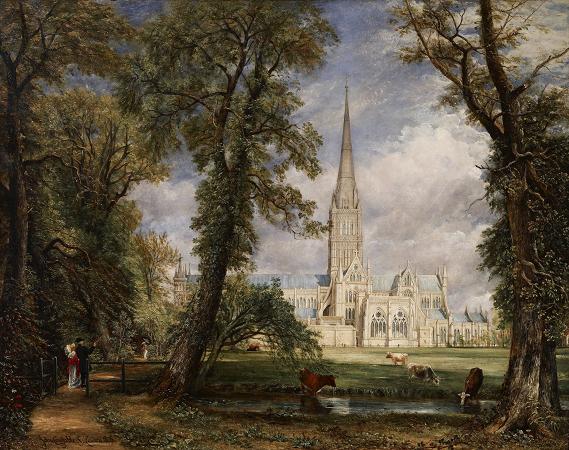Landscape with Dogs. Cultural depictions of dogs extend back thousands of years to when dogs were portrayed on the walls of caves. Representations of dogs in art became more elaborate as individual breeds evolved and the relationships between human and canine developed. Hunting scenes were popular in the Middle Ages and the Renaissance. Dogs were depicted to symbolize guidance, protection, loyalty, fidelity, faithfulness, alertness, and love. As dogs became more domesticated, they were shown as companion animals, often painted sitting on a lady's lap. Throughout art history, mainly in Western art, there is an overwhelming presence of dogs as status symbols and pets in painting. The dogs were brought to houses and were allowed to live in the house. They were cherished as part of the family, and were regarded highly by the upper classes, who used them for hunting and could afford to feed them. Hunting dogs were generally connected to the aristocracy. Only the nobility were allowed to keep hunting dogs, and this would signal status. It was the signalment of a noble man. Dog portraits became increasingly popular in the 18th century, and the establishment of The Kennel Club in the United Kingdom of Great Britain and Ireland in 1873, and the American Kennel Club in 1884 introduced breed standards or word pictures, which further encouraged the popularity of dog portraiture. The walls of caves and tombs dating back to the Bronze Age have illustrations or statues of dogs. These generally portray dogs used for hunting, and even children's toys and ceramics depicting dogs.Some of the prehistoric paintings are found in Bhimbetka rock shelters, these paintings depict dog on a leash with a man. Rock art of Tassili n'Ajjer also include depiction of dog. The Ancient Greeks and Romans, contrary to the Semitic cultures, favored dogs as pets, and valued them for their faithfulness and courage and were often seen on Greek and Roman reliefs and ceramics as symbols of fidelity. Cats were not favoured over dogs, on contrary Ancient Greeks and Romans didn't keep cats as pets. Dogs were given as gifts among lovers and kept them as both pets, status symbols or kept for guardians and as hunting dogs. Dogs were appreciated by the Greek for their faith and love. Homeros Odyssey tells the story of Odysseus who had a dog called Argos he raised and who was the only one that recognized him when he returned home after his travels, disguised to conceals his appearance. Only the old dog recognized him instantly. This theme has been often depicted in on ancient Greek vases. The Ancient Romans kept three types of dogs. Hunting dogs; especially sighthounds, Molossus type of dogs like the Neapolitan Mastiff were often depicted in reliefs and mosaics with the words Cave Canem; and small companion dogs of Maltese type as women's lap dogs. Greyhounds were often depicted too, often as sculptures. Large dogs were often used in war by the Roman army in attack formations or for wolf-hunting on horseback, which was a popular sport. Generally, dogs symbolize faith and loyalty. A dog, when included in an allegorical painting, portrays the attribute of fidelity personified. In a portrait of a married couple, a dog placed in a woman's lap or at her feet can represent marital fidelity. If the portrait is of a widow, a dog can represent her continuing faithfulness to the memory of her late husband. An example of a dog representing marital fidelity is present in Jan van Eyck's Arnolfini Portrait. An oil painting on oak panel dated 1434 by the Early Netherlandish painter Jan van Eyck, it is a small full-length double portrait, which is believed to represent the Italian merchant Giovanni di Nicolao Arnolfini and his wife, presumably in their home in the Flemish city of Bruges. It portrays a wedding scene, where the people invited to witness the ceremony can be seen in the convex mirror at the back, the mirror symbolizing the eye of God. In those times people were not always married in the church, it was enough that two witnesses were present to make a wedding legal. A number of symbols can be found in the picture: the fruit, the symbol of fertility and wealth, the shoes removed, and the dog. The oranges casually placed to the left are a sign of wealth; they were very expensive in Burgundy, and may have been one of the items dealt in by Arnolfini. The little dog symbolizes in the Middle Ages iconography faithfulness, devotion or loyalty, or can be seen as an emblem of lust, signifying the couple's desire to have a child. Unlike the couple, the dog looks out to meet the gaze of the viewer.
more...




